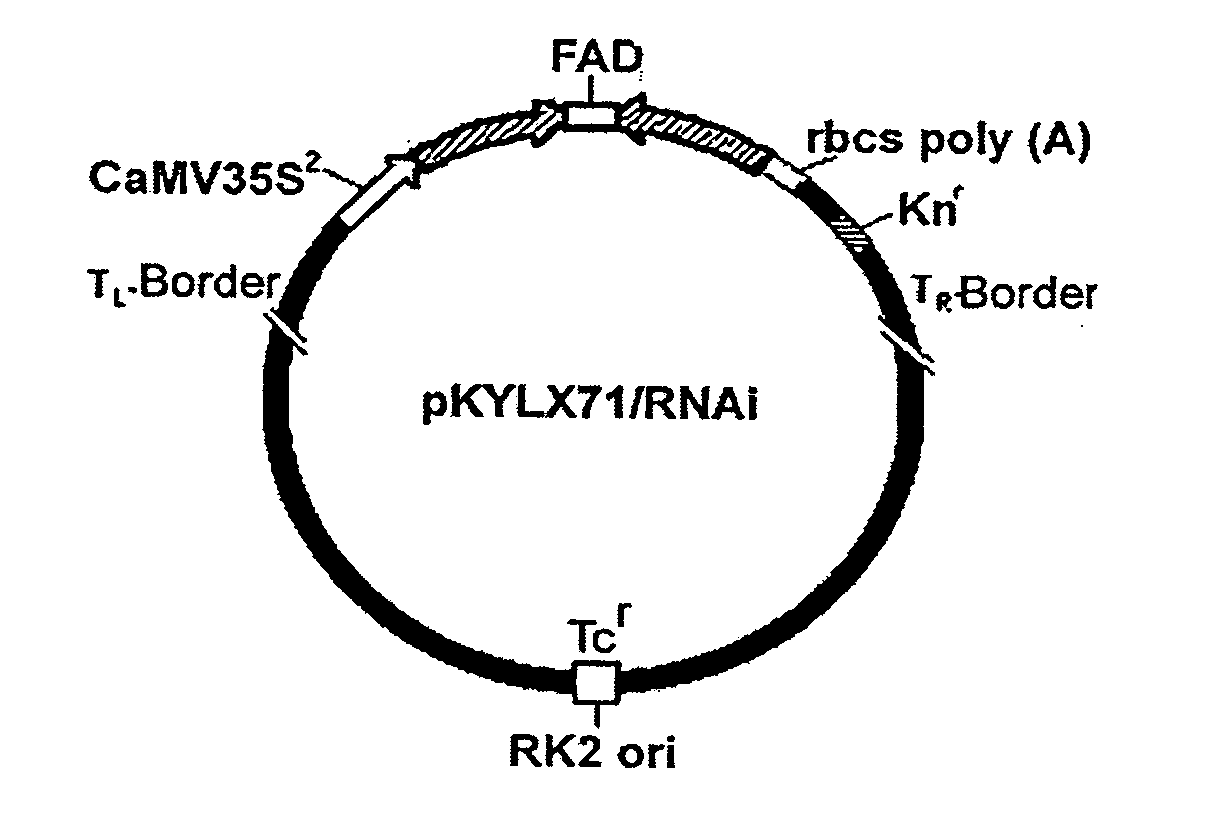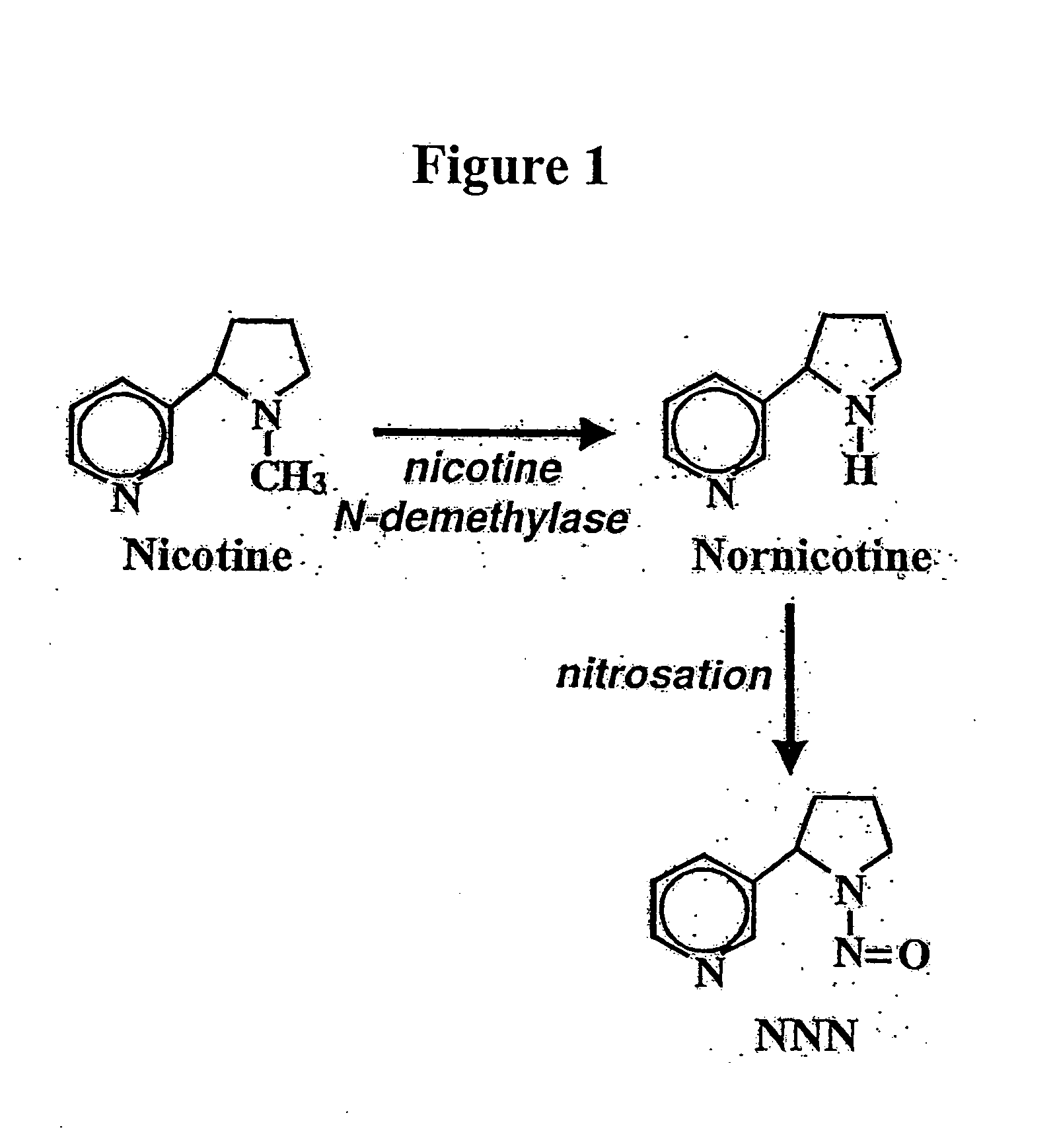Alteration of tobacco alkaloid content through modification of specific cytochrome P450 genes
- Summary
- Abstract
- Description
- Claims
- Application Information
AI Technical Summary
Benefits of technology
Problems solved by technology
Method used
Image
Examples
example 1
Generation of EST Databases
[0180]RNAs isolated from senescing leaves of the converter genotype DH 91-1307-46(Con) and its near-isogenic nonconverter counterpart DH 91-1307-46(NC) were used to generate cDNA libraries. High-throughput automated DNA sequencers were initially used to generate single-run sequence information (ESTs) for 11,136 randomly chosen cDNAs from the converter library. The local alignment search tool BLASTX (Altschul et al. (1990) J. Mol. Biol. 215:403-410) was used to compare the predicted protein sequence of each tobacco cDNA with the nonredundant protein database curated by the National Center for Biotechnology Information of the National Library of Medicine and National Institutes of Health. Subsequently, a similar annotated EST database was generated by conducting sequencing runs on 11,904 cDNAs selected from the nonconverter library.
example 2
Microarray Analyses of Converter CDNA Library
Methods
[0181]Upon completion of the EST database generated from the converter cDNA library, the inserts from 4992 clones were amplified by PCR and spotted onto glass slides. Given the possibility that the nicotine demethylase enzyme may be catalyzed by an enzyme of the P450 class of oxidative enzymes, special attention was given to library entries that were predicted by BLASTX analysis to encode P450s.
[0182]From visual inspection of the BLASTX results, it was estimated that 31 unique P450 genes were represented in the database. When selecting specific 96-well plates to be included on the microarray, care was taken to ensure that all unique P450 genes would be included among the 4992 cDNAs selected.
[0183]RNAs isolated from the near-isogenic Burley genotypes DH 98-326-3 (nonconverter) and DH 98-326-1 (converter), and DH 98-325-5 (nonconverter) and DH 98-325-6 (converter) were used to generate Cy3- and Cy5-labeled cDNAs. To maximize the meta...
example 3
Microarray Analysis of CDNA Non-Converter Library
[0190]Upon completion of the EST database from the nonconverter library (generated from senescing leaves of genotype DH 91-1307-46 (NC)), another set of microarray experiments was initiated. For this next generation of microarrays, the goal was to produce glass slides containing the complete nonredundant set of genes represented in both libraries.
[0191]To obtain an estimate of the number of unique genes that are represented in the database, clustering analysis was conducted to identify ESTs predicted to be represented multiple times in the database (contigs) versus those predicted to be represented only once (singletons) (Huang and Madan (1999) Genome Res. 9:868-877). Due to the nature of the clustering algorithms, sequences showing high, but imperfect, sequence identities are clustered into the same contig. The total set of predicted unique genes, or unigenes, within a database is calculated as the sum of the contigs and singletons. ...
PUM
| Property | Measurement | Unit |
|---|---|---|
| Fraction | aaaaa | aaaaa |
| Fraction | aaaaa | aaaaa |
| Fraction | aaaaa | aaaaa |
Abstract
Description
Claims
Application Information
 Login to View More
Login to View More - R&D
- Intellectual Property
- Life Sciences
- Materials
- Tech Scout
- Unparalleled Data Quality
- Higher Quality Content
- 60% Fewer Hallucinations
Browse by: Latest US Patents, China's latest patents, Technical Efficacy Thesaurus, Application Domain, Technology Topic, Popular Technical Reports.
© 2025 PatSnap. All rights reserved.Legal|Privacy policy|Modern Slavery Act Transparency Statement|Sitemap|About US| Contact US: help@patsnap.com



